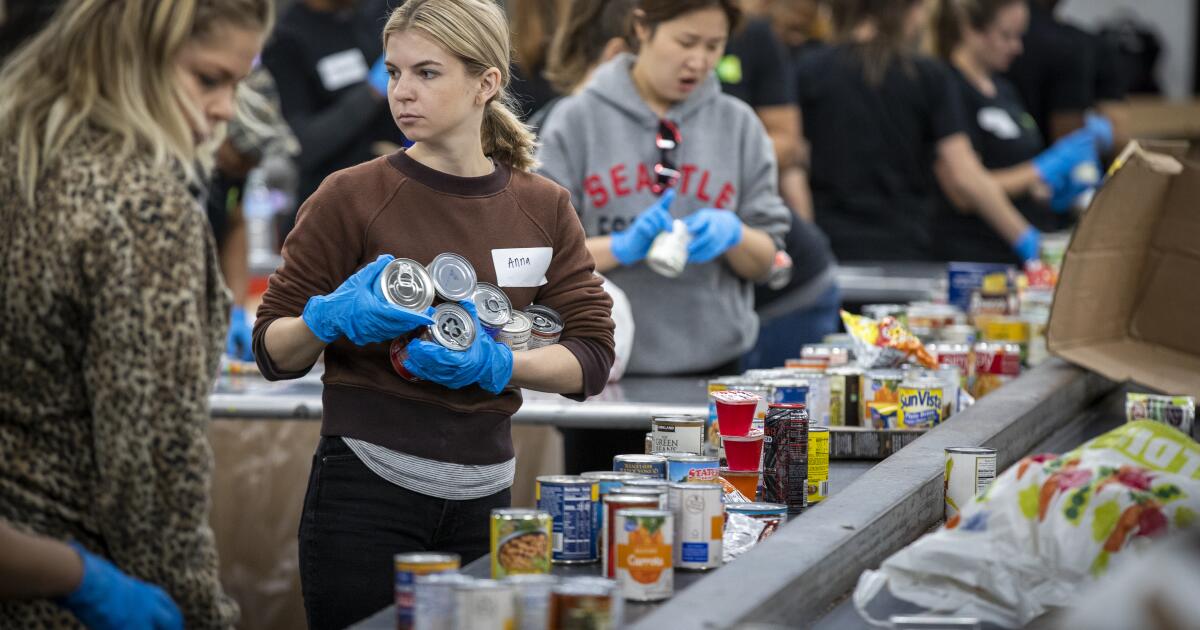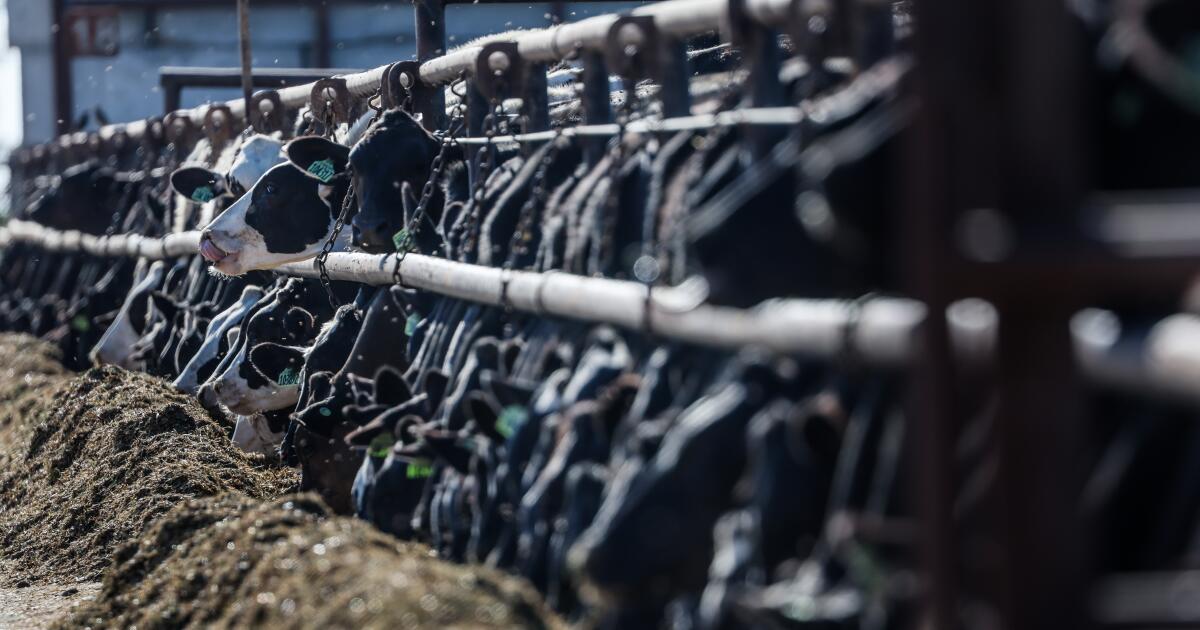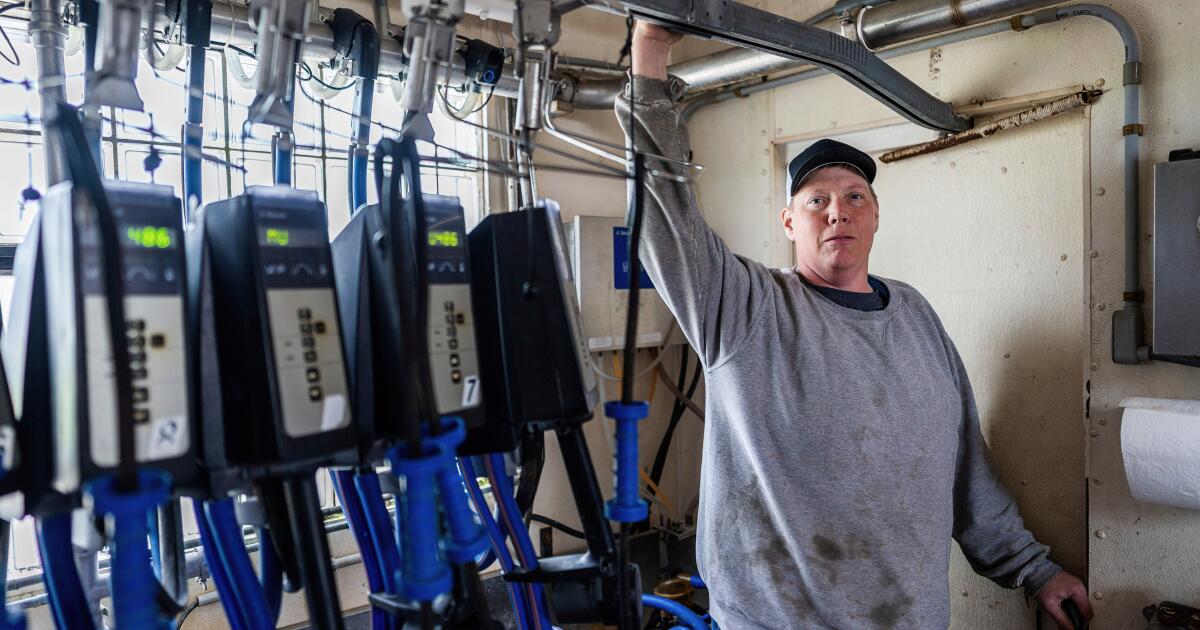The federal government has paid California dairy farms more than $230 million to subsidize losses in milk production resulting from bird flu, records show, an amount that the dairy industry expects to climb higher as more claims for damages are processed.
The H5N1 bird flu has swept through more than 75% of California’s 1,000 dairy farms since August 2024, sickening cattle and leading to steep dropoffs in milk production.
Farmers were able to get relief under a U.S. Department of Agriculture program known as the Emergency Assistance for Livestock, Honeybees and Farm-Raised Fish Program, or ELAP. The program usually provides assistance for farmers impacted by wildfires, drought and flooding but was opened up for dairy farmers last year as bird flu began ravaging their cows.
U.S. Department of Agriculture records show that 644 payments were made to 359 California dairy farms between November 2024 and June 2025 totaling $231 million. The average per farm payment was about $645,000, and ranged from $2,058 to the Pereira Dairy Farm, in Visalia, to $4.4 million to Channel Islands Dairy Farm, in Corcoran.
Those payments are expected to go much higher, however, as more claims are submitted and processed. Many of the payments issued in May and June were for outbreaks in 2024, suggesting there are more to come.
The relief payments were obtained through a Freedom of Information Act request by Farm Forward, a nonprofit group that advocates against factory farming. The group asserts that the subsidies help prop up industrial-scale dairy operations that perpetuate the spread of bird flu.
“These are mega industrial operations that are fueling an outbreak,” said Andrew deCoriolis, Farm Forward’s executive director. “Bird flu spreads in exactly the kinds of environments that we’re paying to preserve.”
Anja Raudabaugh, the chief executive of the industry’s largest state trade group, Western United Dairies, said the payments have “ensured our dairy communities and their workers stay employed and healthy. Until we get approval of a dairy cow vaccine, weathering this storm has only been possible with the assistance of the milk loss payments.”
Jonathan Cockroft, managing partner of Channel Islands Dairy Farms, said while the payments helped with the roughly 30% drop in milk production his farm experienced, his losses exceed the $4 million he received.
He said the virus caused cows to abort their pregnancies, and often prevented them from getting pregnant again. A dairy cow that doesn’t give birth doesn’t produce milk. In other cases, he said the udders were so scarred by the disease that the cows were unable to produce milk at levels prior to infection.
“There’s a whole other version I’m not sure the public understands, which is the huge impact on reproduction,” he said.
He also noted many animals died — especially when the outbreak first hit last fall, and the newness of it combined with the blazing heat of the Central Valley felled 10% to 15% of many California herds.
Joey Airoso, a dairy farmer in Tipton, received a $1.45-million subsidy for an outbreak at his farm last October.
He said the outbreak has cost him more than $2 million “just on milk income and that does not include the over $250,000 of extra care costs” required to treat cows with medicines, extra staffing and veterinary consultations.
And it doesn’t cover the cost of the cows that died — which can’t produce milk or be sold for meat. The average dairy cow costs about $3,500, Cockroft said.
Jay Van Rein, a spokesperson for California’s Department of Food and Agriculture, said the loss payments are “the most realistic way for producers to recover and to avoid huge disruptions in the food supply of these products.”
USDA officials didn’t immediately respond to a request for comment, but a former top USDA official who left the agency in January said it was important to provide dairy farmers relief once the agency identified H5N1 bird flu in a handful of Texas herds in March 2024. By then the disease had been spreading for weeks, if not months, making containment to one state impossible.
“This was a once-in-a-lifetime event, and we knew that we were going to need to support producers, and we knew that the quicker we could get some assistance out to them to help them test, the better off we were going to be, and the faster we’d be able to bring the infection under control,” he said.
Farm Forward’s DeCoriolis and others, however, say these programs perpetuate an agricultural industry designed around containing hundreds, if not thousands, of genetically similar animals into confined lots — veritable playgrounds for a novel virus. He also noted the federal relief programs don’t come with any strings attached, such as incentives for disease mitigation and/or biosecurity.
Angela Rasmussen, a virologist at the University of Saskatchewan’s Vaccine and Infectious Disease Organization in Canada, said handing out subsidies to farms without trying to understand or investigate the practices they are using to quash the disease is a mistake.
“What are they doing on the farms to prevent reinfection?” she said.
The USDA payments were based on a per cow milk production losses over a four-week period. According to Farm Forward’s data, several farms received more than one subsidy. While roughly half received just one payment, 100 farms received two payments, 58 received three, 19 received four and two received six separate payments.
At one farm in Tulare County, four USDA payments were submitted once a month between November 2024 and February 2025. At another, payments stretched from December 2024 to May 2025.
Rasmussen said the multiple payments most likely stemmed depending on specific circumstances at the dairies involved.
Cockroft of the Channel Islands Dairy said he and other farmers have seen waves of reinfection and milk tests that remain positive for months on end. He said he knew of a farm that was in quarantine for nine months.
When herds are quarantined, animals are not allowed to be transferred on or off site. In California, a farm is under quarantine for 60 days after initial virus detection. It can’t move out of quarantine until tests show its milk is virus-free — for three weeks in a row.
Van Rein, the state agriculture spokesperson, said the average time under quarantine is 103 days. He said that of the 1,000 herds in California, 940 are not under quarantine; 715 of those had previously been infected and released from quarantine.
A quarantined farm can still sell milk, however, even if the milk tests positive. Pasteurization has been shown to kill the virus.
The relief payments are another sign of how the U.S. government supports the agricultural industry, which is considered by some to be vital to the national interest.
“We’ve decided politically that this is an industry that we want to support, that was hit by something that obviously wasn’t their fault, and we’re going to help them, because it was a disastrous thing that hit the industry,” said Daniel Sumner, an agricultural economist at UC Davis. “If we thought about these payments as we’re using our tax money to help somebody who’s in need, because their family is poor, that’s not the case.”






